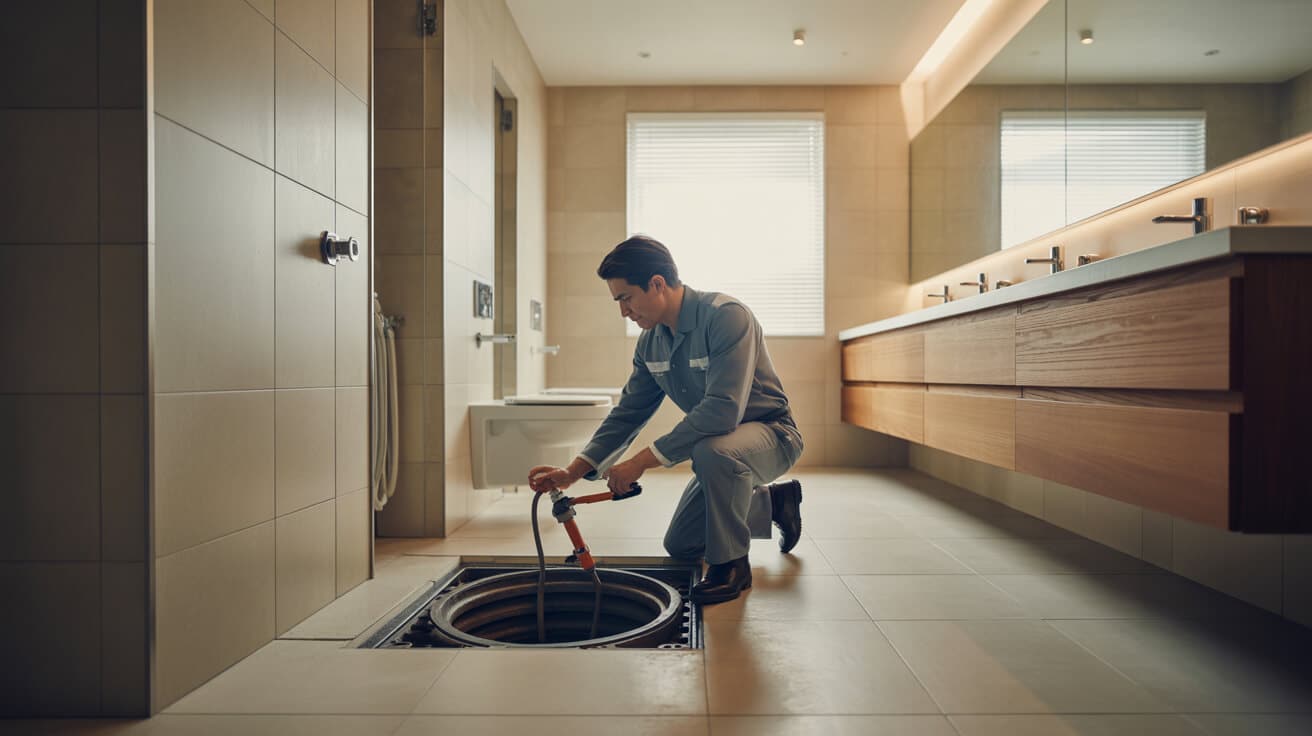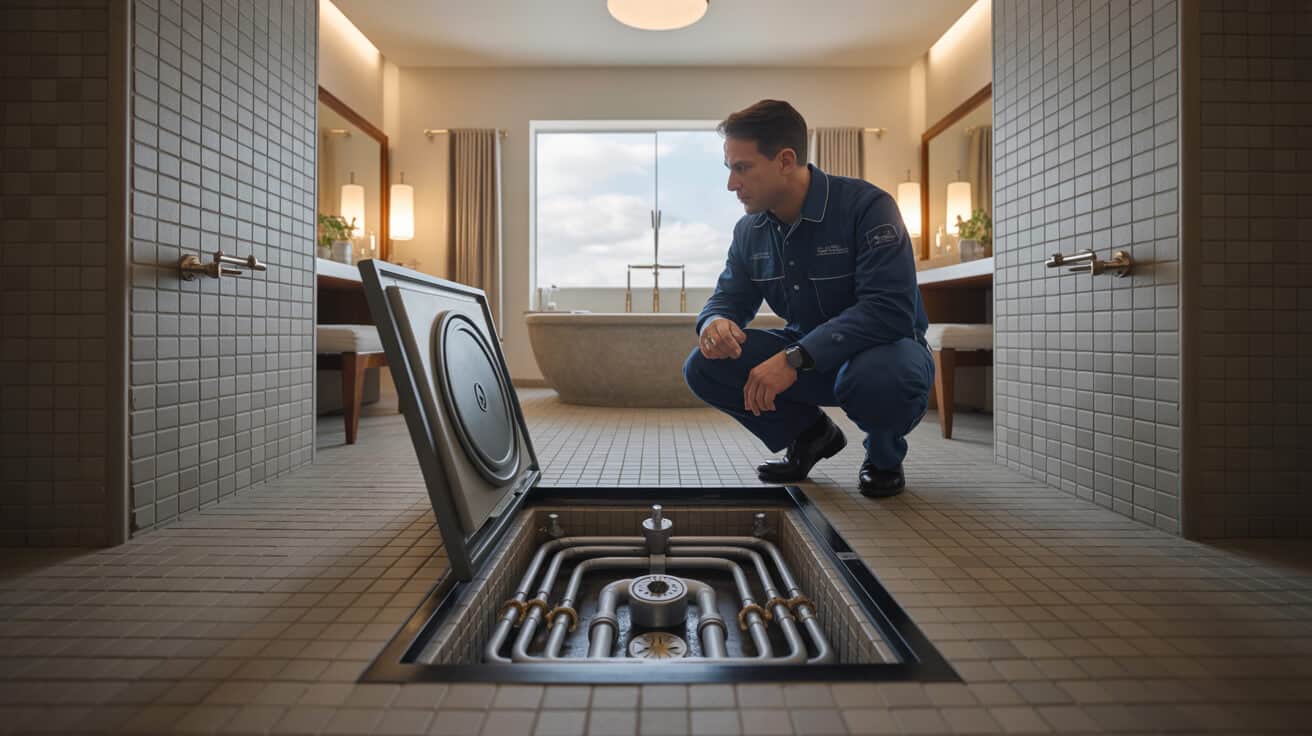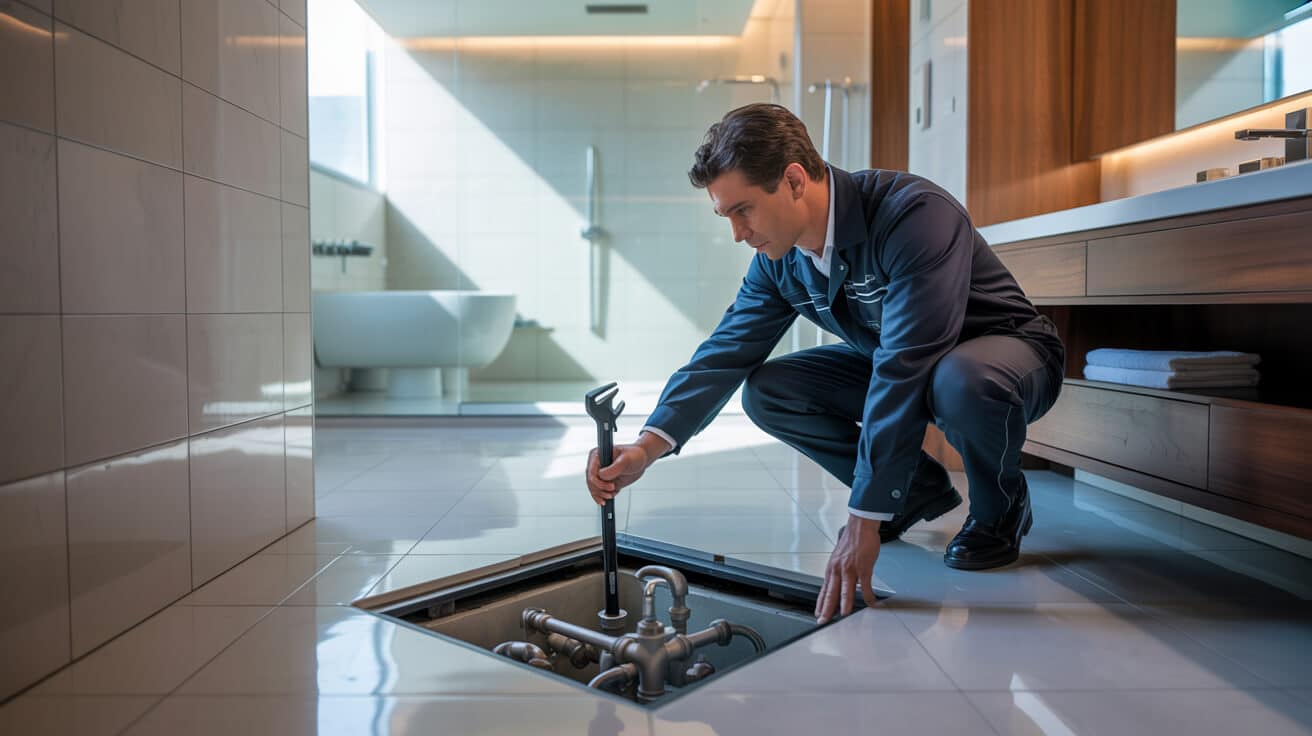Manhole chambers—also known as inspection chambers or access vaults—enable essential maintenance for drainage and sanitation systems across residential, commercial, and municipal assets. Service integrity relies on the soundness of these subsurface units, which provide points for intervention, sampling, and compliance with environmental or building regulations. Structural decay, material fatigue, and system mechanical stress create vulnerabilities that can compromise drainage, water quality, and property health. Effective repair, especially as provided by firms like Plumbers 4U, reduces risk and aligns property operations with legal and safety expectations for your organisation.
Etymology or Name Origin
The term “manhole” reflects historical engineering conventions for access to buried utility conduits, large enough for a person to enter. Usage diverges across regions and industries, with “inspection chamber” describing smaller, often non-person-entry units, and “maintenance hole” serving as a modern synonym. Variants such as “access chamber” arise in technical specifications, while colloquial and regulatory preferences shift based on location and building codes.
Alternate Terms in Industry
| Term | Typical Usage |
|---|---|
| Manhole | General access for utility services |
| Inspection chamber | Small, shallow, limited-entry points |
| Maintenance hole | International building code documents |
| Access chamber | Utility engineering and industry plans |
Overview / Context
Manhole chambers provide controlled access to drain lines, branch connections, and system junctions within sanitary infrastructure. Installations may be situated:
- At points of direction change or pipe junctions
- At fixed intervals along extended drainage runs
- In proximity to major plumbing features, such as sump locations, grease management stations, or boiler discharge points
In multi-unit or commercial facilities, the presence and condition of these chambers directly affect regulatory compliance. Their configuration and material specification must adapt to the nature of your property, required load-bearing, and environmental exposure.
Modern standards demand frequent inspection and proactive repair, as deteriorating chambers lead to unmanaged inflow, root ingress, surface flooding, or enforcement penalties. Companies like Plumbers 4U often deliver assessment, repair, and compliance in bundled property services, aligning scheduled maintenance with your business risk profile or property portfolio.
History
Origins
Chambered access to subsurface waste removal traces to ancient Rome, where stone-lined vaults supported urban sanitation. Mediaeval towns evolved separate stormwater and sewage routes, but it was the 19th-century development of combined sewer systems that standardised chamber design for large-scale service coverage.
Industrial Emergence
The Victorian period institutionalised brick-lined manholes, with heavy iron covers and modular dimensions for citywide coordination. Advancements in cement technology and public health regulation (e.g., Public Health Act, late 1800s UK) accelerated widespread adoption. By the 20th century, agencies mandated scheduled inspection intervals and specified minimum construction standards, setting the stage for modern property management.
Contemporary Evolution
Recent decades introduced materials such as sulphate-resisting concrete, high-density polyurethane, and composite resins, markedly improving resistance to corrosive environments. Digitised inspection technologies now integrate with asset databases, and specialist platform companies—including Plumbers 4U—deliver integrated diagnostics, legal compliance, and scalable scheduling systems. Chamber repair now reflects a balance between heritage system demands and innovative remediation technologies.

Concept / Description
A manhole chamber is defined by its core components: a watertight base (often forming a U-shaped “invert”), rise walls of brick, concrete, or polymer, a sloped concrete benching to direct flow and minimise standing debris, and a surface cover and support frame. The structural design must:
- Withstand external loading (traffic, soil movement)
- Prevent infiltration or exfiltration of water or waste
- Accommodate branch connections at a diversity of angles and elevations
For your property, the specification and design details are governed both by the site’s functional demand and the regulatory regime—categories such as accessible manhole (suitable for personnel entry), shallow inspection chamber (non-entry), and special-purpose flushing point inform the structure’s internal volume and surface footprint.
Component Overview Table
| Component | Function | Material Options |
|---|---|---|
| Invert/Base | Directs flow, support | Concrete, brick, plastic |
| Walls | Structure and strength | Brick, precast concrete, polymer |
| Benching | Slope for debris removal | Concrete |
| Cover & Frame | Access, loading | Cast iron, composite, steel |
Functionality / Purpose / Applications
Manhole chamber repairs enable your maintenance teams or contracted service providers to restore or enhance the following functions:
- Inspection and Maintenance: Routine and emergency assessment prevents costly failures. Chambers enable plumbing professionals to perform camera surveys, flush debris, or instal root barriers.
- Contingency/Intervention: Acts as points of access in emergencies, such as backups or overflows, where rapid equipment deployment is needed to protect assets or occupant safety.
- Testing and Compliance: Establishes isolation points for flow or leak testing—essential for property sale, insurance, or regulatory certification.
- Asset Documentation and Longevity: Integrates with inventory and maintenance record systems to support your property value and insurer needs.
Key applications span:
- Domestic housing (blockages, wet-weather inflow, resale certification)
- Multi-unit rental (tenant safety, periodic inspection)
- Commercial/industrial settings (higher-load environments, risk mitigation)
- Public property and infrastructure (street works, municipal upgrades)
Classifications / Types / Variants
By Access Level
- Full-Entry Chambers: Large-diameter, permitting physical entry, required for deep networks or trunk sewers.
- Inspection-Only Chambers: Mid-diameter, tool and inspection camera entry, common in domestic installations.
- Rodding Eyes: Minimal, for insertion of rods or jetting nozzles, typically at system extremities.
By Materials
- Traditional Brickwork: Typical in heritage and older properties, requires skilled bricklaying and is vulnerable to mortar washout.
- Precast Concrete: Durable and consistent, supports rapid installation for new builds.
- High-Density Polymer or Composite: Lightweight for difficult access sites, increasingly specified for corrosion and flow resistance.
By Drainage System
- Sanitary/Foul Water: Handling wastewater from internal plumbing.
- Surface Water: Rainwater management, integration with permeable surfaces or retention systems.
- Combined Chambers: Systems handling both stormwater and sanitary influx, requiring stricter maintenance to prevent contamination.
Systems / Tools / Methodologies
Diagnostic Tools
- CCTV Survey Equipment: Miniaturised cameras provide internal imaging and defect mapping—essential for risk ranking and pre-repair diagnostics.
- Smoke and Dye Testing: Traces leaks or defective connections that may not be visible from above.
- Hydraulic Testing and Flow Metering: Assesses chamber throughput, detects partial blockages impacting system resilience.
Essential Repair Tools
- Masonry and Concrete Tools: For patch repair, benching rebuilding, crack injection, and grouting.
- Compaction Equipment: Wackers and compactors stabilise backfill after chamber works.
- Root Cutting and Removal Devices: Mechanised units extract root ingress threatening system flow.
- Safety and Rescue Gear: Harnesses, tripods, atmospheric gas monitors as stipulated by the Confined Spaces Regulations.
Methodological Steps
- Site Preparation and Risk Assessment
- Chamber Cleaning and Water Pump-Down
- Defect Identification (Visual, CCTV, Hydraulic)
- Targeted Repair (Material and Method Selection)
- Testing and Documentation
- Surface Reinstatement

Stakeholders / Entities Involved
Service Delivery
- Plumbing and drainage companies specialising in subterranean access and repair.
- Multi-trade property service firms able to coordinate regular maintenance and compliance mandates.
Client Base
- Owners and Occupiers: Protecting your living or business environment against sanitation risk and capital loss.
- Property Managers/FMs: Mitigating risk, ensuring compliance across portfolios, leveraging repair records for asset reporting.
- Local Authorities/Commercial Clients: Demanding legal conformity, high resilience, and robust documentation.
Regulatory and Oversight
- Building control officials, local authorities, water undertakers, and environmental agencies provide standards and oversight.
Legal / Regulatory / Ethical Considerations
Regulatory Landscape
- UK Building Regulations (Part H): Requires accessible inspection points, prescribes spacing, and mandates maintenance.
- Water Industry Act 1991: Governs alterations or repairs to systems connecting with public sewers.
- Confined Spaces Regulations 1997: Specifies mandatory safety, entry, and rescue provisions for chamber entry tasks.
- WRc/BS EN13508 Standards: Detail inspection, coding of defects, quality thresholds for remediation, and materials.
Ethical and Legal Duties
- Duty of Care: Extends to your organisation’s tenants, customers, and neighbouring properties, obliging timely repair and hazard prevention.
- Reporting and Permits: Notifying local authorities or water undertakers as required, especially for works affecting public obligations or environmental risk.
Insurance and Documentation
- Repair actions should be fully logged, including before-and-after photographs, certificates of completion, and—where possible—fit with your company’s digital asset management for future reference.
Performance Metrics / Data / Measurements
Key Performance Areas
- Repair Recurrence Metrics: Tracks fix lifespan and signals need for systemic upgrades.
- Turnaround Time: Measures the speed of response and completion—for your property or business, this insulates against unplanned downtime.
- Compliance Rate: Monitors maintenance and inspection adherence, facilitates asset management, and impacts insurance eligibility.
Sample Metrics Table
| Metric | Description | Impact |
|---|---|---|
| Defect Recurrence Rate | Repeat repairs in defined timespan | System reliability |
| Repair Turnaround | Average time to service and restore | Occupant/business continuity |
| Inspection Interval | Time between scheduled maintenance checks | Compliance and risk management |
| Up-time Ratio | Period operational vs. downtime | Service-level assurance |
Challenges / Barriers / Limitations
Operational/Technical
- Sites in dense occupancy, close proximity to other assets, or deep excavation require higher coordination and specialised equipment.
- Hidden historical modifications or undocumented pipe runs undermine rapid diagnosis.
- Risks from precipitation, groundwater, or unstable soils complicate drying and benching repairs.
Economic and Social
- Repair cost sensitivity can lead to deferred maintenance, amplifying long-term liability.
- Out-of-hours or emergency repairs subject property users to schedule disruptions, increasing stakeholder friction.
Policy and Philosophy
- Tension persists between minimum compliance and best practice—your organisation or company may face pressure to balance operating expenses against reputational risk or social responsibilities.
Impact / Influence / Legacy
Manhole chamber repair supports sanitation resilience, public health integrity, and property asset value. Failure to address surveyed defects leads to escalating liability—regulatory fines, insurance exclusions, or flood remediation. Your documented repairs help underpin property valuation and support investor and regulator confidence. Broader cultural and policy narratives increasingly recognise the significance of preventative maintenance in sustaining urban and commercial environments.
Future directions, cultural relevance, and design discourse
Technology and Innovation
- Introduction of robotic survey tools and rapid-setting, eco-friendly repair compounds redefines repair speed and cost-effectiveness.
- Adoption of composite resin liners, modular chamber parts, and hybrid benching promote flexibility and service longevity.
Sustainability and Culture
- Movement toward greener chamber design and repair—reducing environmental footprint, minimising inflow and infiltration, and preserving urban groundwater regimes.
- Companies like Plumbers 4U integrate digital documentation and transparent scheduling, promoting trust and engagement with your property or your commercial organisation.
Contemporary Discourse
- Increased public awareness and policy debate underscore the tension between infrastructure legacy and future adaptation.
- As repair standards evolve, your organisation or property stands to benefit from proactive alignment with evolving best practices, cementing resilience and value in the face of environmental, social, and regulatory shifts.

